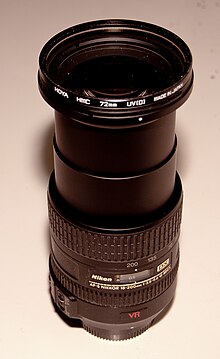 | |
| Maker | Nikon |
|---|---|
| Technical data | |
| Type | Zoom |
| Focal length | 18-200mm |
| Focal length (35mm equiv.) | 27-300mm |
| Crop factor | 1.5 |
| Aperture (max/min) | f/3.5 - f/22 (wide) f/5.6 - f/29 (tele) |
| Close focus distance | 0.50m |
| Max. magnification | 1/4.5 |
| Diaphragm blades | 7 (rounded) |
| Construction | 16 elements in 12 groups |
| Features | |
| Ultrasonic motor | |
| Lens-based stabilization | |
| Macro capable | |
| Application | Wide angle - telephoto |
| Physical | |
| Max. length | 162 mm (@ 200mm) |
| Diameter | 77mm |
| Weight | 560 g |
| Filter diameter | 72mm |
| Accessories | |
| Lens hood | HB-35 |
| Case | CL-1018 |
| Angle of view | |
| Diagonal | 76° – 8° |
| History | |
| Introduction | November 2005 |
| Discontinuation | July 2009 |
The Nikon AF-S DX VR Zoom-Nikkor 18-200mm f/3.5-5.6G IF-ED is an image stabilised superzoom lens manufactured by Nikon for use on Nikon DX format digital SLR cameras. It provides a single-lens "walk-around" solution for wide-angle through to telephoto shots, as well as close-up photography.

Introduction
Nikon announced the first version of this lens on November 1, 2005. [1] The lens offers a 35 film equivalent focal length range of 27-300mm, with a compact silent wave autofocus motor featuring full-time manual override and internal focusing. Its second generation Vibration Reduction technology [2] claims to provide compensation equivalent to an increase in shutter speed of four stops. The lens has sixteen lens elements in twelve groups, with two ED glass elements to reduce chromatic aberration, and three aspherical elements to reduce image distortion. Although this lens was designed for use on Nikon DX format DSLRs, its Nikon F lens mount allows it to be used on Nikon full-frame DSLRs, albeit with vignetting due to a smaller image circle. This lens also works with teleconverters. [3]
On July 30, 2009, Nikon announced an updated variant, the AF-S DX NIKKOR 18-200mm f/3.5-5.6G ED VR II. It adds a zoom lock to prevent zoom creep. [4]

Reception
Reviewers have praised the lens for its 11.1x focal length range, effective vibration reduction, excellent autofocus motor and its versatility. [5] [6] However, the lens has been criticised for pronounced and complex distortion across the range, extreme softness at certain focal lengths and zoom creep. Overall, it has garnered generally positive reviews, citing the lens' flexibility and ability to "allow the photographer to travel light and never miss a shot while changing lenses". [5]
Problems
The lens has problems with auto-focus of near subjects and in wide-angle position of infinity subjects on some older Nikon digital camera bodies. [7] The problem occurs in Nikon D 300 S also.[ citation needed]
The slow auto-focus problem can be solved in new DSLR cameras disabling the light bulb guide that's built in the body camera. Enabling only one point of focus and enabling "continuous engine focus" or "automatic" instead of single servo, may speed up auto-focus greatly to normal again.
See also
References
- ^ a b "AF-S DX VR Zoom-Nikkor 18-200mm f/3.5-5.6G IF-ED (11.1x)". Lenses. Nikon Corporation. 2008. Archived from the original on 2009-10-17. Retrieved 2009-10-23.
- ^ "Nikon Technology - VR (Vibration Reduction)". Archived from the original on 2012-10-26. Retrieved 2014-12-01.
- ^ Teleconverter for 18-200 mm Nikkor VR
- ^ "AF-S DX NIKKOR 18-200mm f/3.5-5.6G ED VR II". Nikon Corporation. 2010-07-30. Archived from the original on 2009-08-02. Retrieved 2010-02-02.
- ^ a b Andy Westlake (2008-02-26). "Nikon 18-200mm f/3.5-5.6G IF-ED AF-S VR DX Lens Review: Conclusion". Digital Photography Review. Retrieved 2010-02-02.
- ^ Thom Hogan (2009-04-09). "AF-S Zoom-Nikkor ED 18-200mm f/3.5-5.6G IF DX VR". Retrieved 2010-02-02.
- ^ Nikon USA. "Lens announcement". Lens announcement. Nikon USA. Retrieved 15 July 2011.
External links
- AF-S DX VR Zoom-NIKKOR 18-200mm f/3.5-5.6G IF-ED Product Page at Nikon.com
- AF-S DX NIKKOR 18-200mm f/3.5-5.6G ED VR II Product Page at Nikon.com
- AF-S DX VR Zoom-NIKKOR 18-200mm f/3.5-5.6G IF-ED review at Digital Photography Review
- AF-S DX VR Zoom-NIKKOR 18-200mm f/3.5-5.6G IF-ED review at Cameralabs
- AF-S DX VR Zoom-NIKKOR 18-200mm f/3.5-5.6G IF-ED review by Thom Hogan